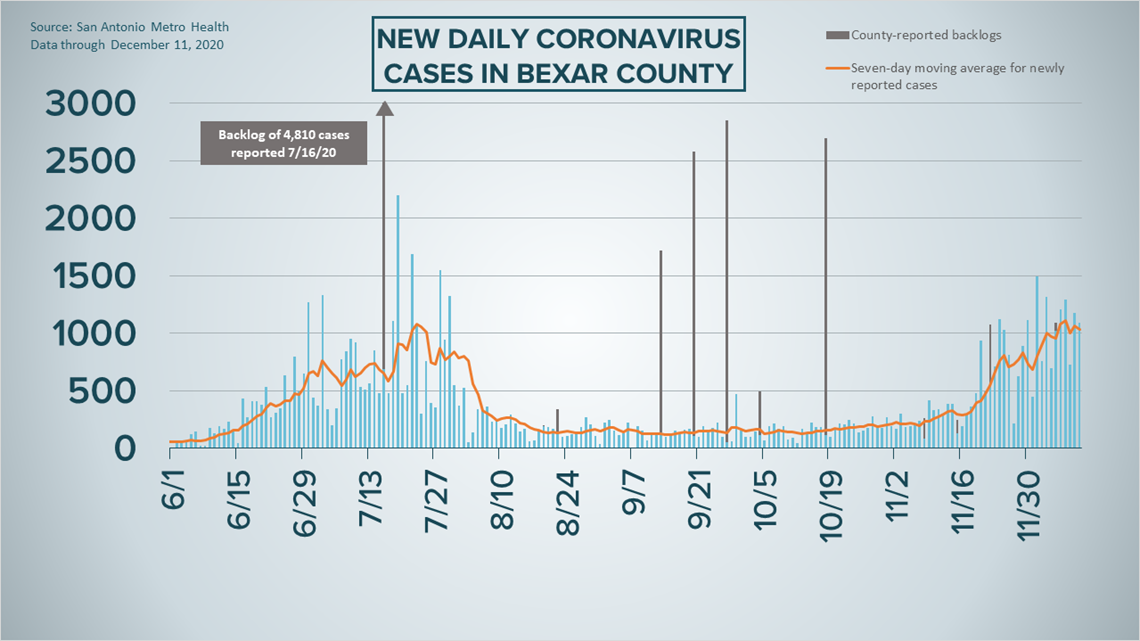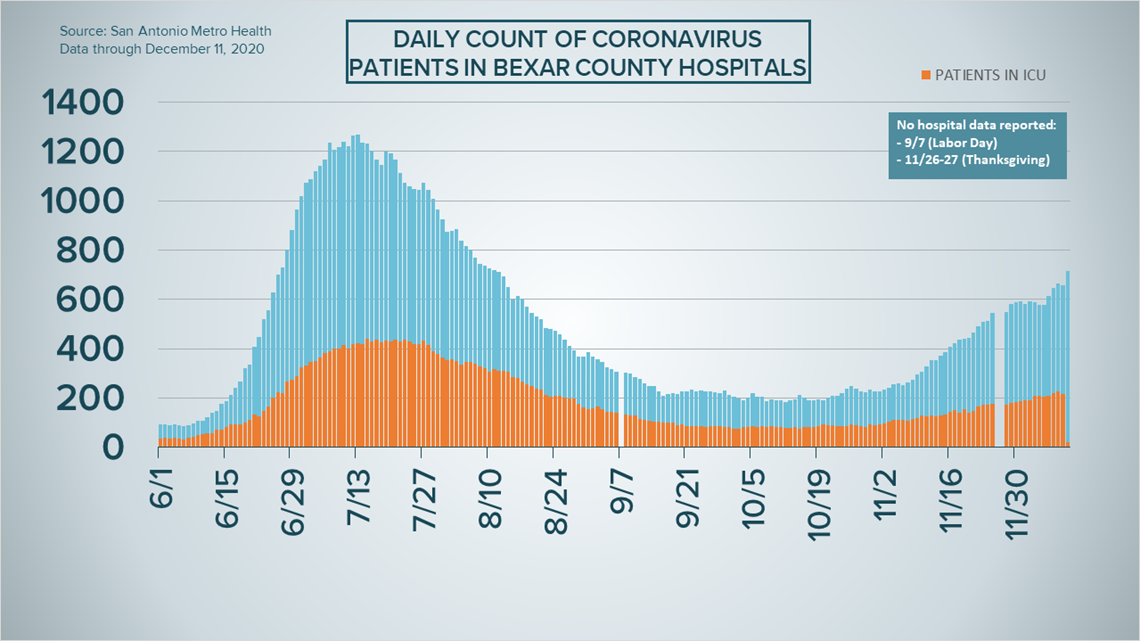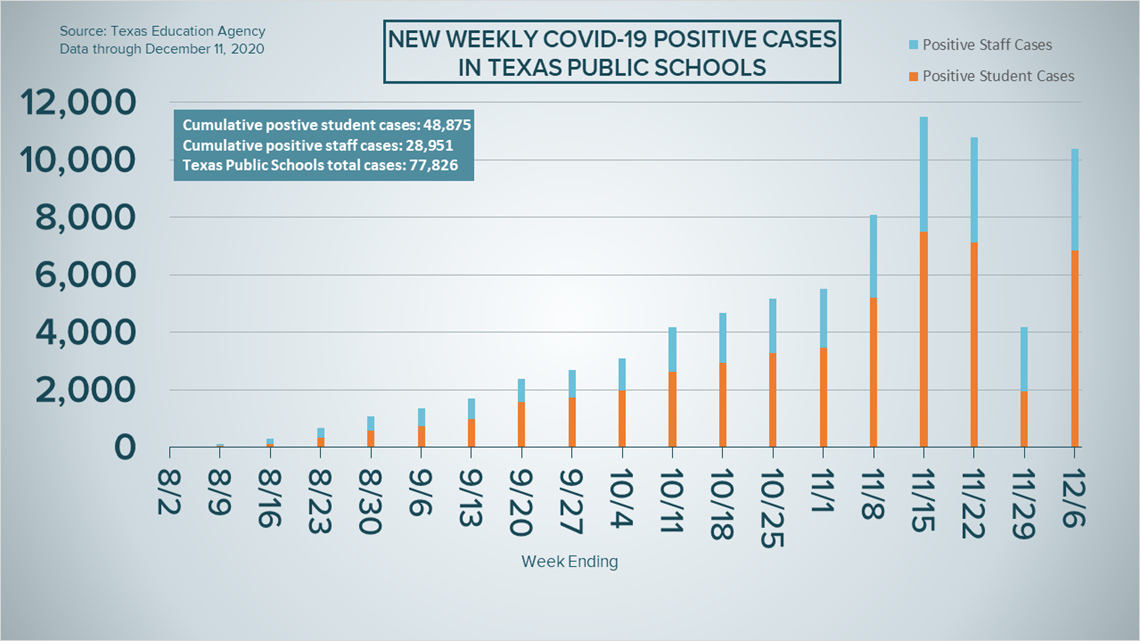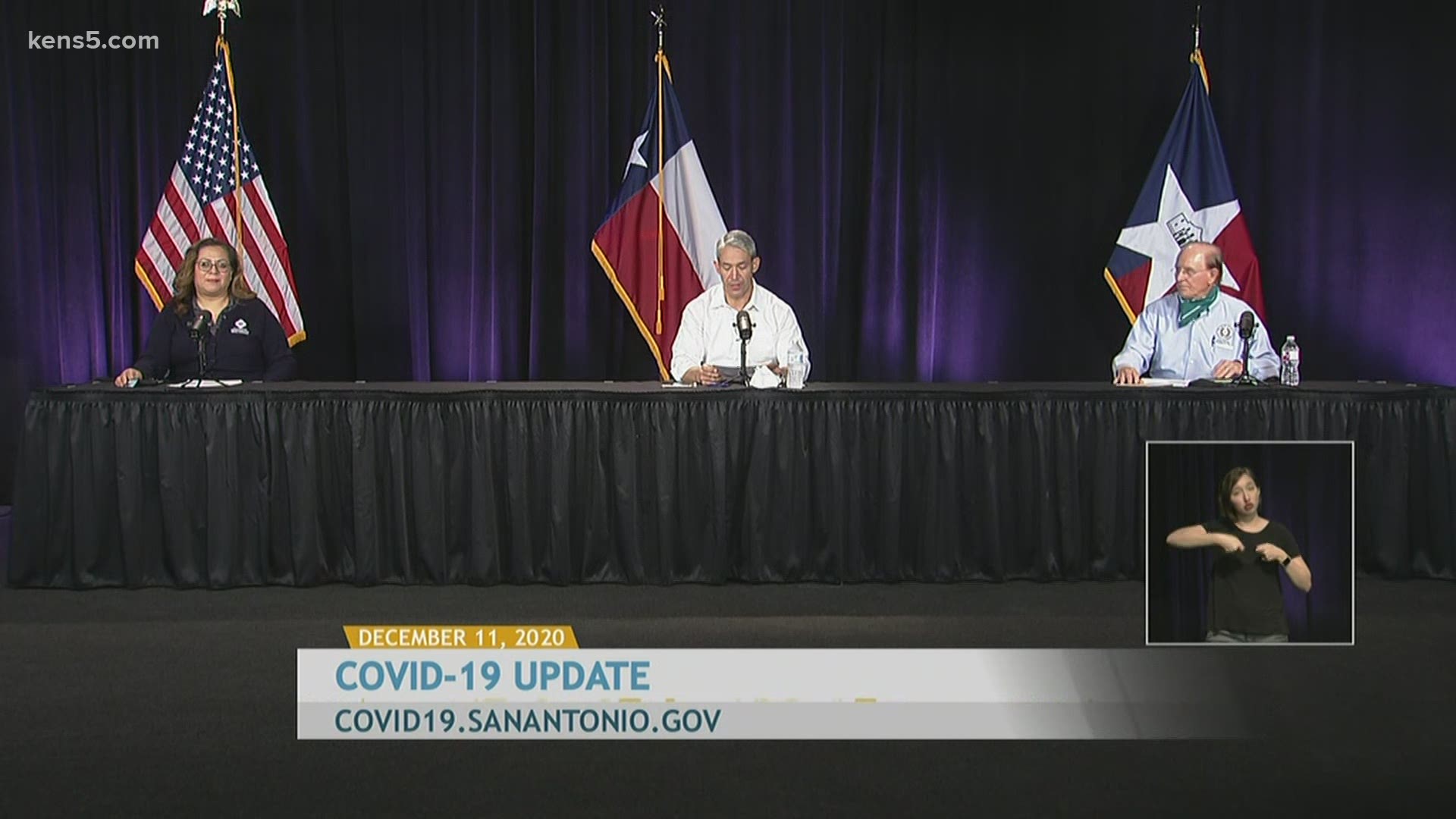SAN ANTONIO — We're tracking the latest numbers from the coronavirus pandemic in San Antonio and across Texas. Here are the latest numbers reported by Bexar and surrounding counties:
- Bexar County: 1,090 new cases were reported on Friday, bringing the total number of cases to 92,484. 6 new deaths were reported, raising the death toll to 1,418.
- Hays County: Officials in Hays County on Friday reported 75 new cases in the county and no additional COVID-related fatalities. As of Friday, there are a total of 8,091 lab-confirmed local cases (1,057 of which are active), while the death toll remained at 107. 6,927 residents have recovered from the virus.
- Comal County: Comal County reported an additional 66 coronavirus cases – 15 confirmed, 51 probable – on Friday, bringing its total to 5,272. Officials also tallied one more coronavirus-related fatality, bringing the death toll for the county to 136. The county estimates 725 active cases on Friday, while 4,411 residents have recovered.
More county case information is available through the Texas Department of Health Services COVID-19 dashboard.
How Bexar County is trending
We've tracked how many coronavirus cases have been confirmed in Bexar County from the time officials began reporting cases in March 2020. The graphic below shows the number of cases since June and charts those daily case numbers along a 7-day moving average to provide a more accurate picture of the overall coronavirus case curve in our area and the direction we're trending amid the pandemic.
On Friday evening, Mayor Ron Nirenberg reported an additional 1,090 coronavirus cases. A total of 92,484 county residents have been diagnosed in the ongoing pandemic, and the seven-day moving average for daily cases dipped slightly from 1,063 to 1,030.
Nirenberg also reported six more deaths from coronavirus complications; at least 1,418 Bexar County residents have died from COVID-19.


Since Monday, Bexar County has added 5,498 cases and 27 deaths to its tally.
As of Friday, 716 patients are receiving treatment for COVID-19 symptoms at area hospitals. Of those patients, 115 are on ventilators and 223 are in intensive care.


Friday marked the first time since August 12 that hospitalizations had jumped over 700 patients currently receiving treatment. Bexar County Judge Nelson Wolff noted that the number is growing, albeit at a slower rate than it did over the summer. Wolff cited the 10-day growth between June 17-27, when cases ballooned from 241 to 730; in contrast, it took 50 days -- from October 24 through December 11 -- for similar growth to occur.
Coronavirus in Texas
The total number of novel coronavirus cases in the state since the pandemic began grew by 16,990 on Friday, according to the Texas Department of State Health Services.
That total includes 14,147 new confirmed cases, 2,624 probable cases, and 219 cases attributed to backlogs not previously reported in the state's total (more details can be found at the top of this page).
As of Friday, 1.448 million Texans have been diagnosed with COVID-19. Of those, 1.307 million diagnoses are confirmed via molecular testing, while another 845,365 are positive antigen tests.
State health authorities also reported 240 additional virus-related deaths on Friday. At least 23,565 Texans have died from COVID-19 complications.
The number of COVID-19-related hospital patients in the state rose by 64 over the last 24 hours; in all, 9,109 Texans are receiving treatment at hospitals for coronavirus symptoms. Meanwhile, the state estimates that 1.157 million Texans have recovered, while 254,063 Texans remain ill with COVID-19.
The latest update from the Texas Education Agency showed that there have been 77,826 cumulative cases among staff and students across the state through Dec. 6. That number comprises 48,875 positive student cases and 28,933 staff cases. More information can be found here.


The TEA releases new data on school cases on Fridays.
Latest Coronavirus Headlines
- Hill Country healthcare workers to visit sister facilities for coronavirus vaccine
- Rural hospitals in Texas feeling left out of COVID vaccine distribution
- 'Superspreader' wedding guests with COVID-19 worked at nursing home. Now, at least 15 people are dead
- FDA could approve Pfizer COVID-19 vaccine for emergency use on Friday
- Nine months on the pandemic’s front line have crushed Texas health care workers' spirits and killed their colleagues
- COVID-19 vaccine questions answered
- Senators Sanders, Hawley push another $1,200 check for Americans
Coronavirus symptoms
The symptoms of coronavirus can be similar to the flu or a bad cold. Symptoms include fever or chills, cough, shortness of breath or difficulty breathing, fatigue, muscle or body aches, headache, new loss of taste or smell sore throat, congestion or runny nose, nausea or vomiting and diarrhea, according to the Centers for Disease Control.
Most healthy people will have mild symptoms. A study of more than 72,000 patients by the Centers for Disease Control in China showed 80 percent of the cases there were mild.
But infections can cause pneumonia, severe acute respiratory syndrome, kidney failure, and even death, according to the World Health Organization. Older people with underlying health conditions are most at risk.
But infections can cause pneumonia, severe acute respiratory syndrome, kidney failure, and even death, according to the World Health Organization. Older people with underlying health conditions are most at risk.
Experts determined there was consistent evidence these conditions increase a person's risk, regardless of age:
- Chronic kidney disease
- COPD (chronic obstructive pulmonary disease)
- Obesity (BMI of 30 or higher)
- Immunocompromised state (weakened immune system) from solid organ transplant
- Serious heart conditions, such as heart failure, coronary artery disease, or cardiomyopathies
- Sickle cell disease
- Type 2 diabetes
The CDC believes symptoms may appear anywhere from two to 14 days after being exposed.
Human coronaviruses are usually spread...
- Between people who are in close contact with one another (within about 6 feet).
- Through respiratory droplets produced when an infected person coughs, sneezes or talks. These droplets can land in the mouths or noses of people who are nearby or possibly be inhaled into the lungs.
- Some recent studies have suggested that COVID-19 may be spread by people who are not showing symptoms.
Help stop the spread of coronavirus
- Stay home when you are sick.
- Eat and sleep separately from your family members
- Use different utensils and dishes
- Cover your cough or sneeze with your arm, not your hand.
- If you use a tissue, throw it in the trash.
Find a Testing Location
City officials recommend getting a COVID-19 test if you experience fever or chills, cough, shortness of breath or difficulty breathing, fatigue, muscle or body aches, headache, new loss of taste or smell, sore throat, congestion or runny nose, nausea or vomiting, or diarrhea.
San Antonio operates several no-cost testing locations, including two walk-up locations open Monday-Sunday from 10 a.m. until 2 p.m.:
Cuellar Community Center
5626 San Fernando St.
San Antonio, TX 78237
Ramirez Community Center
1011 Gillette Blvd.
San Antonio, TX 78224
Additionally, Freeman Coliseum offers drive-through no-cost testing from Monday through Sunday between 9 a.m. and 4 p.m. An appointment is required and can be made either online or by calling (833) 213-0643.
Here's a Testing Sites Locator to help you find the testing location closest to you in San Antonio.

